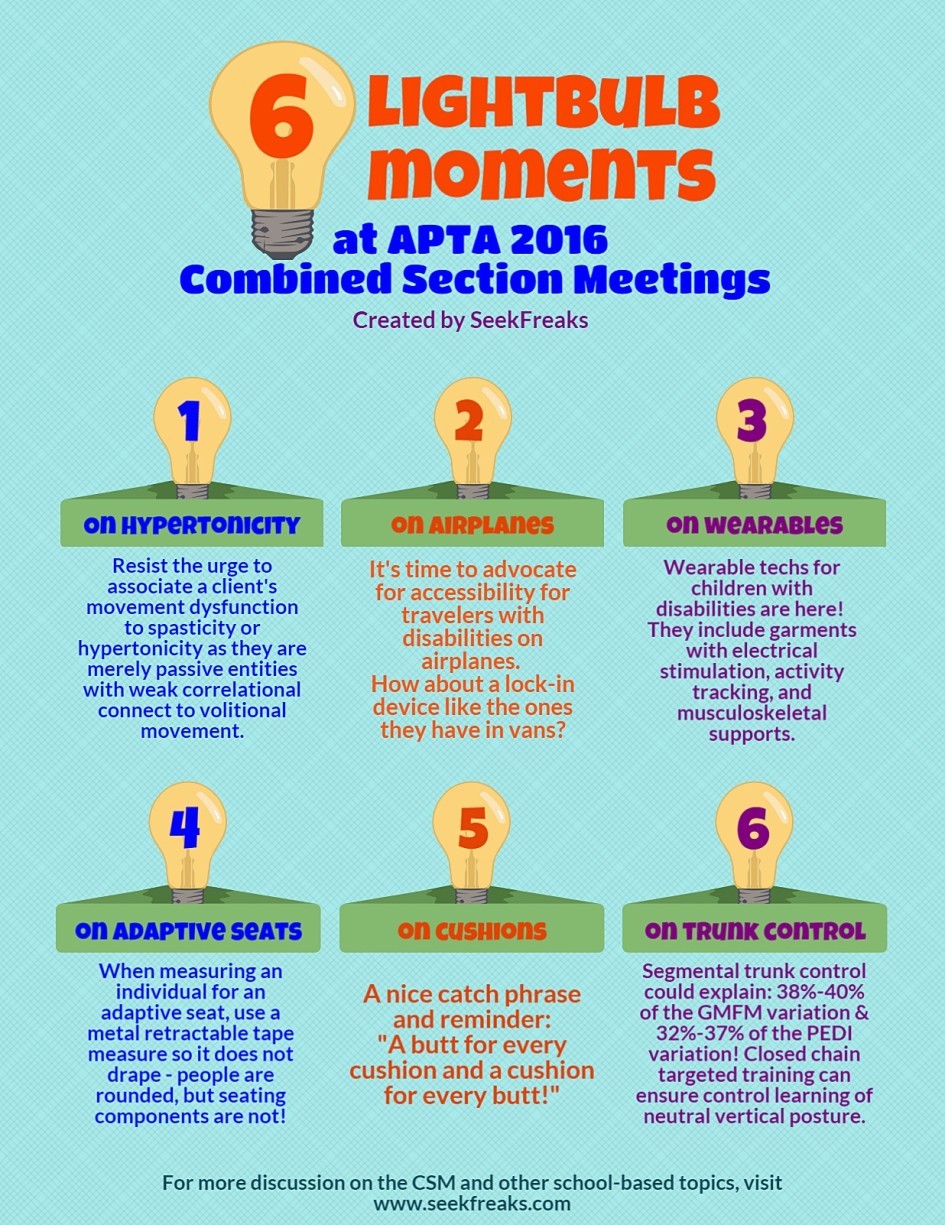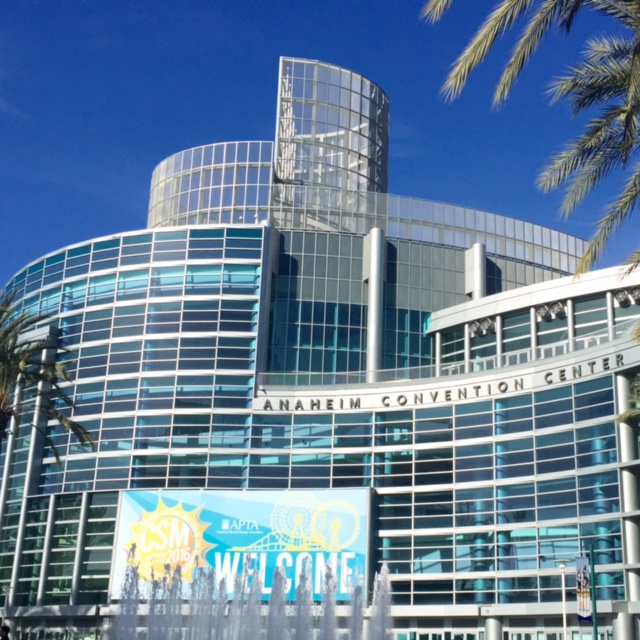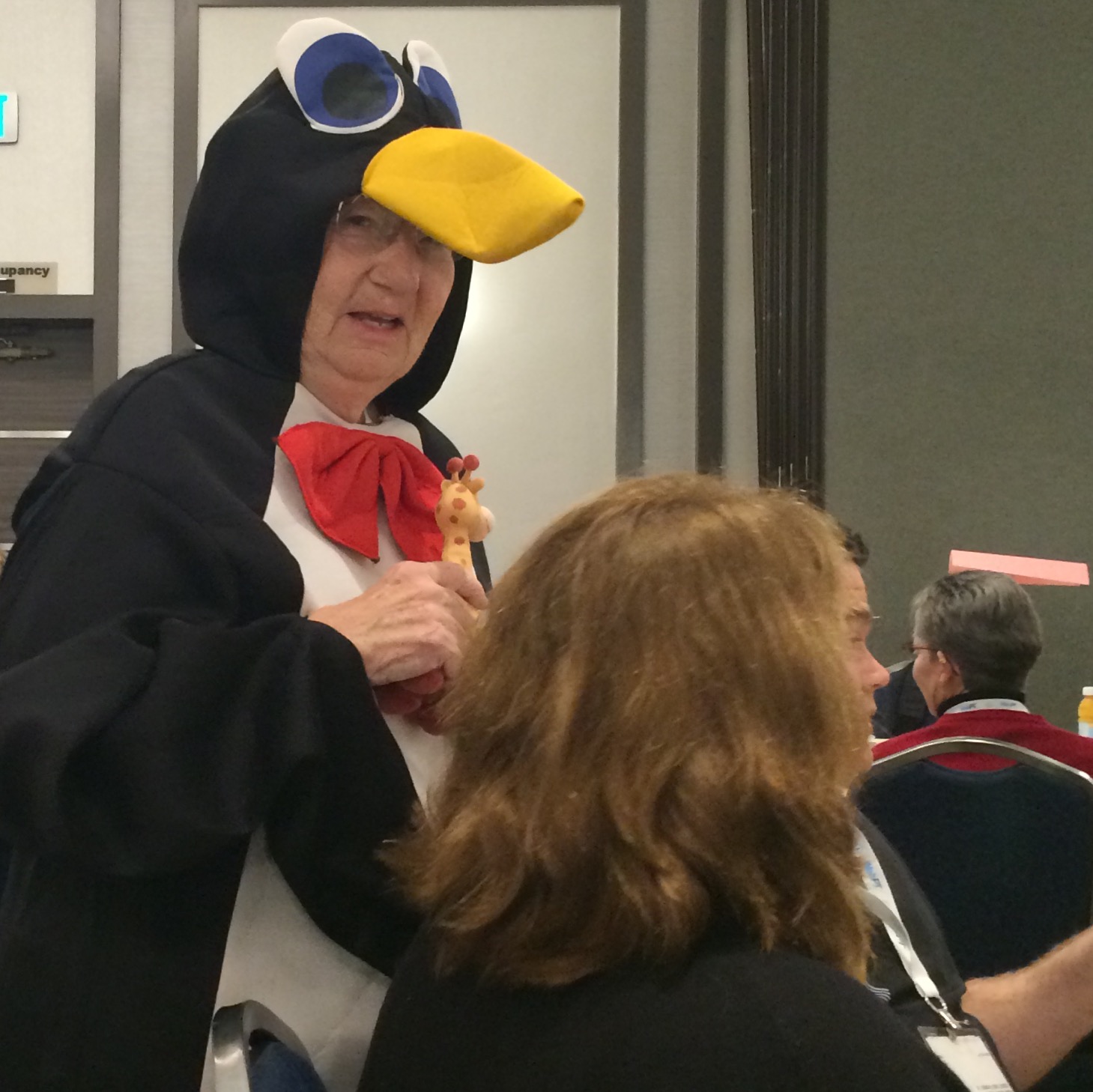[smbtoolbar]
So, this year CSM had over 11,000 participants who came to Anaheim. This SeekFreak was there and connected with other like-minded PTs. One on the reasons we started this website was to continue the great conversations we have at conferences throughout the year with other PTs who continually seek new information and evidence for school-based practice. Hopefully, if you just discovered SeekFreaks, you will review the whole website and make comments on what you find! Also, let us know what articles you would like to see, topics you would like covered and share the Freakish goodness with others…
On Thursday, February 18, from 8-10am, I went to Documenting to Support Medical Necessity, Part 1: Eval & Re-eval (Pvt Pr). They had a good review of key points to document for evaluation (PT diagnosis, secondary complications, function, basics: cardiovascular, integumentary, pain, cognition). The primary point was to demonstrate through your evaluation report all your clinical reasoning that went into it. Don’t just report the student’s performance on the playground, include why the playground is the best place to evaluate this student’s needs.
Another tip is to include medical terms by using parenthetical comments to the parent-friendly report. In this way, you can convey your professional judgement in a way parents understand and provide clarity about your PT diagnosis using our discipline’s language. The biggest take-away for me was how critical the plan of care is not only for us, but also for delegation and for reimbursement audits.
I snuck out early to catch the last of the Pediatric Platform Presentations. I caught Dr. Palisano’s platform Characterization of Therapy Services for Children with Cerebral Palsy that examines therapy services provided to children with CP. Again, school-provided services were not included!! They found that children with more significant impairment received more PT sessions, there was no correlation between age and number of sessions with a wide variety in number of sessions provided (besides age and motor function). Finally, they found that parents reported family-centered practices and that PTs met family needs for their children. Yes!
Another session that was popular with the school-based crowd was FUNctional Fashions & Wearable Tech for Kids with Disabilities (Peds). Various items were presented to the tech-hungry participants, including garments with electrical stimulation, activity tracking, and musculoskeletal supports. The one I heard talked about the most was the Playskin Lift Exoskeletal Garment. These garments have external structural supports and designs to improve movement. You may want to check out this handout, I am!
Part of attending CSM is evaluating the many sessions that are interesting, committing to one and dealing with any regret that comes when hearing your colleagues describing the mind-altering session they chose!
From 11am-1pm, I attended Research Forum 2016: Valid Measures for Body Structures and Function (Peds). Here are some measures that piqued my interest
- SCALE = Selective Control of the Lower Extremity
- a numeric score for 5 joints:
- Hip, Knee, Ankle, Subtalar, Toes
- For each joint Selective Voluntary Motor Control is graded as:
- Normal = 2 points
- Unable = 0 points
- Impaired (anything else) = 1 point
- Maximum of 10 points per limb
- Valid & reliable
- Prognostic factor (no change expected with therapy)
- Correlates with hip & knee coordination during gait/activity level
- a numeric score for 5 joints:
- Pediatric Neuromuscular Recovery Scale
- Adapted from Adult Neuromuscular Recovery Scale
- Not fully established psychometrics
- Tested on children with SCI, with likely application to CP & Spina bifida
- Across ages 18 months – 12 years
- Requires more than 1 trained testers
- Takes 1-1.5 hours to administer
- Can discern incremental changes with more severely involved children, during the change
- Testing Muscle Strength
- For research and clinical purposes, “Isokinetic” Dynamometry is the preferred method: most valid, reliable, and sensitive to change
- For the clinic, 5-repetition sit-to-stand test shows promise with regards to reliability, validity, and minimal detectable change (MDC) scores between ages 5 – 12 in CP
At 3-5p, I wanted to see For Kids and Kids at Heart: A New Generation of Technology for Social Mobility (Peds) but it was cancelled. Rats! So I went to Updates on Pediatric Clinical Practice Guidelines (CPGs) Development and Implementation (Peds). “Clinical practice guidelines are statements that include recommendations intended to optimize patient care that are informed by a systematic review of evidence and an assessment of the benefits and harms of alternative care options.”
Our Section has a strategic planning goal of 5 CPGs in 5 years. In 2013, a CPG for Congenital Muscular Torticollis was completed. Currently, these CPGs are in development:
- Developmental Coordination Disorder
- Gait Analysis for Children with Cerebral Palsy
- Prevention of Spinal Deformities in Children with DMD (on hold)
These topics are under consideration, but the Section is open to suggestions: Plagiocephaly, Down Syndrome, Scoliosis. I was disappointed to see school-based practice was not even included in the assessment of how the guidelines are used (for hospital, private clinic, home-based, EI center only).
~~~~~~~~~~ 0 ~~~~~~~~~~
On Friday, February 19, 8-10 am, I participated to Development of Segmental Postural Control in Children, Part 1 (Peds). This was the best session I attended. I encourage everyone to download this presentation! It provides an excellent construct for understanding and intervening for posture and postural control. The presenters provided an excellent study: The central role of trunk control in the gross motor function of children with cerebral palsy retrospective cross-sectional study (Curtis, Butler, Saavedra, Bencke, Kallemose, Holm & Woollacott). They established a positive relationship between the segmental level of trunk control and age with GMFM and PEDI Mobility subtests.
Segmental trunk control could explain: 38%-40% of the GMFM variation & 32%-37% of the PEDI variation! Closed chain targeted training can ensure control learning of neutral vertical posture. Gaining head control in neutral vertical carries over into functional skills. Targeted training shows excellent potential for head control problems. Targeted training is a comprehensive approach that includes data-based assessment to target interventions via equipment, home and school programs. This session demonstrated the construct with some excellent case studies.
At 11 am-1pm, I went to improve my discernment for Unrelenting Misperceptions of Spasticity & Hypertonicity (Neuro). I loved the fact that these presenters relied heavily on the work of Carol Giuliani, who I have admired for decades.
“If therapists can identify motor dysfunction using concepts of motor control and direct their intervention to the problems of control, they will be using a scientific approach to practice.” – Carol Giuliani, 2002
The presenters asked us: If the evidence consistently demonstrates that spasticity and hypertonicity are not the direct cause of movement dysfunction, why do we persist in assessment and intervention of these impairments with relation to movement dysfunction? The take home messages?
- Resist the urge to associate a patient’s movement dysfunction to spasticity or hypertonicity as they are merely passive entities with weak correlational connect to volitional movement.
- Challenge yourself to manipulate the manner in which your patient is interacting with the environment in order to extract true performance capacity. I think we are ahead of the game on this in school-based practice!
At 3-5 pm, I went to see Dynamic Core Stability in Children with Cerebral Palsy (Peds). They provided a solid review of factors for dynamic stability for the core. I was reminded of how critical the diaphragm is and they provided how they cue for difficult areas like the pelvic floor.
~~~~~~~~~~ 0 ~~~~~~~~~~
Last day! Saturday 2/20 8-10a, I saw Sliding, Slouching, and Squirming: The Nuts and Bolts of Seating, Part 1 (Peds). Basic considerations:
- Patient sits as upright as possible or in their neutral sitting position (may need support). Be aware that everyone’s upright is different!
- Use a metal retractable tape measure so it does not drape: people are rounded, but seating components are not!
- Use foot blocks to position/support the feet.
- Align your line of sight with the tape measure at the correct angle.
- Client Needs for Seating/Mobility
- Pressure Assessment
- Gathering Background Information: health, environments, transportation, funding, present seating/mobility system
- Posture & Function in present seating/mobility system
- Mat Assessment: Joint limitations affecting seating posture
- Sitting Assessment & Hand Simulation
- Material Simulation/Mock-up
- Measurements- Most important measures:
- Seat to PSIS
- Seat to bottom of shoulder blade
- Seat to top of shoulder blade
- Buttock/thigh depth (INDIVIDUAL=left & right)
- IT to back of knee
- Lower leg length
- Hip width
- Trunk width
At 11 am-1 pm, I mixed it up and went to the Clinical Electro & Wound Mgmt Section’s Pressure Ulcers: Treatment, Pressure Management & 24-hr Positioning (ClinElec). I was interested because I think we avoid many integumentary issues with positioning programs. I was hoping to hear some evidence that would help with buy-in or implementation.
I got an excellent reminder about the difference between immersion (which I often consider) = capacity for the cushion to allow the body to sink into it, and envelopment (which I rarely think about) = capability of cushion to deform around and encompass the body. Also a nice catch phrase: ‘A butt for every cushion and a cushion for every butt’. Considerations:
- Level of skin protection needed
- Comfort
- Ability to transfer
- Ability to transport
- Cost
- Ease of cleaning & use
- Durability
- Zone or no zone needed
Last day, last session…3-5p, I got greedy and split my time between 2 sessions.
- Technology for Enhanced Movement in Pediatrics: An Update from Research Summit IV (Peds). I learned a lot about what the Research Summits do and how they work. I think we should try to get our Section to focus on research that could be applied to school-based practice!! The latest Research Summit IV was focused on technology that enhances movement. However, it was focused on infants and what the presenters consider low tech would be considered high tech in the schools! So, I jumped to…
- Advocacy to Advance Inclusion of People with Disabilities (Health Pol). This session was very interesting, it was a panel comprised of people with disabilities, two of whom were also PTs. The audience got involved in some case study discussions which were rich given the panelists’ perspectives. We got pretty interested in how to improve airplane access for travelers in wheelchairs. We want to advocate for airplanes to have lock-in devices like vans have.
~~~~~~~~~~ 0 ~~~~~~~~~~
Outside of the sessions, our Section on Pediatrics voted on a few things during our Business meeting. (Drum roll, please) We are no longer the Section on Pediatrics, we are the Academy of Pediatric Physical Therapists! There was a bit of discussion of what SoPAC will be called but fearless leader Cindy Miles responded that the planning team feels the quality of the conference will withstand the re-branding. (By the way, this year SoPAC will be from November 10-12 in Keystone, Colorado. Make plans to attend early, Keystone is a gorgeous part of the country with lots of hiking, biking and all fun things to do outdoors.)
The membership took part in a rousing discussion of a change in bylaws to respond to an APTA change to allow a full vote to members who are PTAs (they previously had half a vote). Our section could continue to have a half vote for PTAs or change the bylaws to a full vote. There were strong opinions from both sides but the vote passed a full vote for Academy PTAs.
President Joe Schreiber completed his service at this meeting (do YOU want to be president of an Academy? Tell Laura Case you want to run!). Joe also won the GE “Bud” DeHaven Service Award which honors a Section member who has demonstrated sustained and extraordinary service to the Section on Pediatrics. Somehow this was kept from him and was a surprise!! Ann Van Sant was honored with a lectureship to mark her extraordinary, global contributions to pediatric practice. I love going to the Section meeting, you get to meet your professional idols! I chatted with Bob Palisano, saw Ann Van Sant dressed as a penguin and chatted with Susan Effgen and Mary Jane Rapport!!
I thought the conference hotels were really good. Many lovely spots to meet and discuss what you learned, share a drink and talk shop! However, they did seem unprepared for our numbers early in the conference. The Marriott was my favorite gathering place – great patio (we were in CA!), food and libations. I spent a little time in the Hilton where most of our pediatric programming was held. I got turned off from the Hilton by the thumping DJ every evening at 5:30pm (getting old or just like to hear my conversation without effort? You make the call!).
I also glimpsed an amazing ‘connection’ between two young PTs that I have not seen since middle school, basement parties! The food trucks parked outside the convention center were fantastic! Usually, I spend CSM wandering hungry. But these trucks kept me happily fed with fresh, lovely offerings.
I did get out for an In-n-Out Burger, the Cheeseburger, animal-style. Always a treat! I did discover a fantastic breakfast spot, Anepalco’s Café. It was THE most delicious Mexican food with French influences. I fell in love with the Green Chilaquiles! I have a thing for green chilis. I went back and ordered the same thing twice.
Enough with the food! I also spent some great time on the SoCal beaches. I even got in the water, brisk!!
Lots of sun, fun and information! I love to get time with my school-based SeekFreaks in person. Although I am still recovering from jet lag, I am already looking forward to the next conference. I can’t wait until July for Innovations! We are in Milwaukee this year, Mary Massery is returning and the speakers are fantastic. There will be platform presentations for the first time…come and cool off in Wisconsin this summer! Or we will see you at SoPAC or APPTAC (Academy of Pediatric Physical Therapy Annual Conference) or whatever we will call it!! Maybe we can have a SeekFreaks gathering? Cocktails and Conversation in Milwaukee? Beverages and Banter in Keystone? Who is in??














